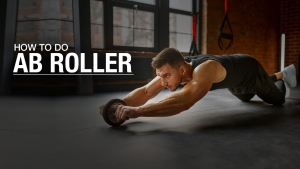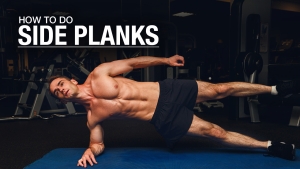
laser targeted oblique workout!
The obliques are truly some of the most fascinating muscles of the entire core.
But let’s face it, the obliques are one of those muscle groups that just don’t get the attention they deserve. They can produce power, ensure postural stability, and support rotation throughout the core.
Unfortunately, when the obliques are trained, they usually aren’t trained in the right way.
Either the wrong oblique exercises are used or there is something off with the position. For example, twisting incorrectly during the Russian Twist.
If you feel lost when it comes to targeting your obliques during a solid core routine, I’m going to help you get back on track.
The oblique exercises that I’m going to show you here today will help to redefine the way you train obliques. Whether you want to have visible muscle definition or strong oblique muscles, I have 10 of the best exercises for obliques that’ll help you achieve your physique goals.
Best of all, you don’t need a dumbbell or multiple weight plates for these exercises. However, a continuous-loop exercise band will be helpful.
ANATOMY OF THE OBLIQUES
Before we jump into the oblique workout, all of this starts with understanding a bit about the anatomy of the obliques.
Knowing how everything ties together will help you develop a stronger mind-to-muscle connection.
The total oblique muscle is made up of external obliques and internal obliques.
EXTERNAL OBLIQUES

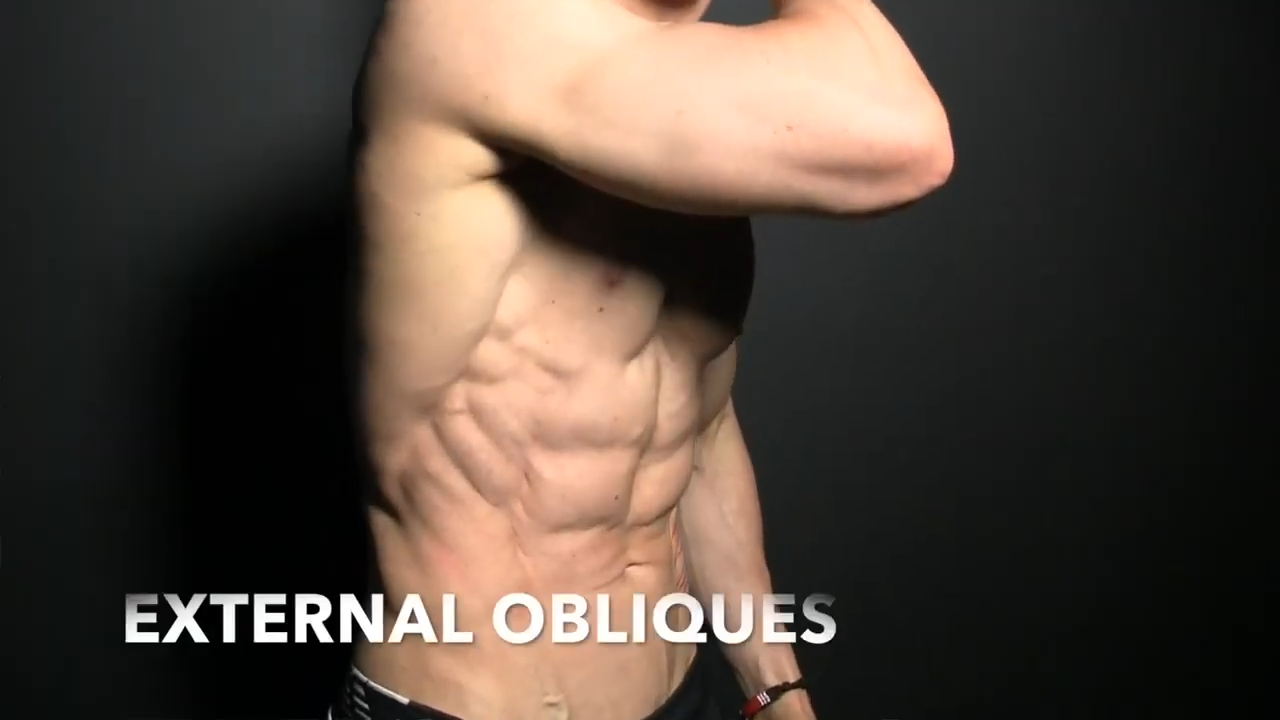
As you’d expect, the external obliques are the visible part of the muscle. In short, these guys steal the show.
This muscle sits above the internal obliques, and they are what most people will focus on when they are training to develop killer obliques.
The external obliques are oriented at a downward angle, and they play an essential role in supporting rotation.
For example, if you’re performing Windshield Wipers, your external obliques are firing like crazy to control the leg positions.
INTERNAL OBLIQUES


Although they don’t get the spotlight like the external obliques do, the internal obliques are just as important.
They run the opposite direction of the external obliques, and they also help with rotation.
FUNCTIONS OF THE OBLIQUES
So, you have both internal and external obliques, and they work together to produce rotation, and more importantly, control rotation. As we’ll see soon enough, in some cases, the obliques prevent rotation altogether.
Your obliques also assist with side bending.
For example, if you are performing a Spiderman Push-up, you are activating the obliques are you bring your knee to meet your elbow.
Obliques also help with the flexion of the trunk. Naturally, this all depends on the movement being used to elicit their contraction.
Single-sided oblique exercises are excellent for assisting or preventing with trunk flexion. A great example would be a single-leg plank. Your body naturally wants to give in and go towards the floor, but your obliques along with the rest of the strong core prevent trunk flexion.
BEST OBLIQUE EXERCISES
It’s time to start targeting your obliques like never before.
You may find that you will be doing fewer repetitions in your workouts, but that your results will be much more significant.
This is because you’ll be using the most effective exercises AND, more importantly, you’ll be performing them correctly.
To get the most out of your oblique exercises, you will want to pay attention to how you are doing every repetition.
Again, this comes back to a strong mind-to-muscle connection.
Let me show you what I mean as I take you through my obliques workout.
1.) SIDE CRUNCH

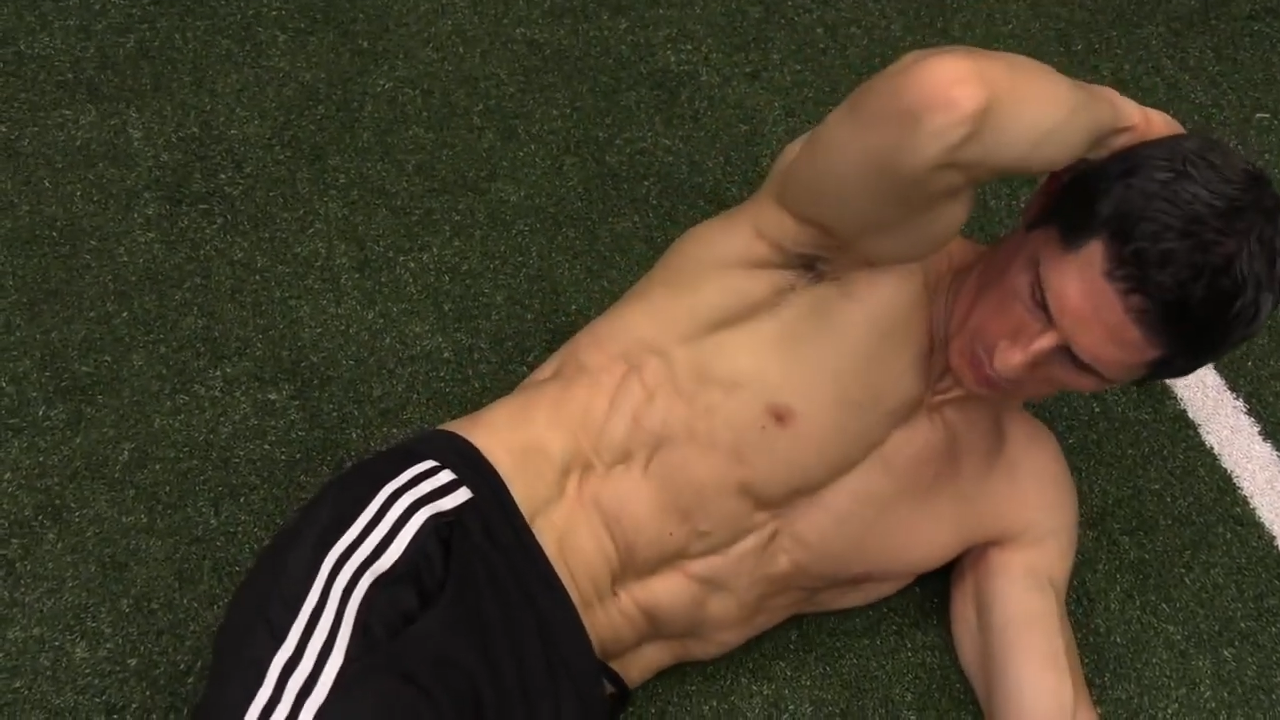
The first oblique exercise is one you’ve probably done thousands of times and no results to show for it. I’m talking about the standard crunch obliques exercise: the Side Crunch.
Now before you roll your eyes and scroll down, hear me out.
Yes, this is one of the simplest ways to train your obliques but that doesn’t mean it’s easy.
When you’re trying to develop your obliques, you need to make sure that every single repetition you do is purposeful. You need to move slowly and when you make every repetition count, this exercise is going to burn like hell.
Exercise Notes: Get into the starting position by laying on your side and placing your hand behind your head. Do not use your hand as a crutch or form of support. Make sure your left knee and left foot are in contact with the ground and not popping up. In order to engage the obliques properly during a Side Crunch, you want to get them a little bit more elongated. You can do this by allowing your left shoulder to go fully down to the ground and then rotate towards the ground to open up the oblique muscle. This little bit of extra rotation ensures the muscle is getting stretched on every rep. When your left elbow comes up at that 45-degree angle, you’ll immediately notice that oblique contraction, which you can emphasize by moving slowly. Switch to the opposite side.
Just for your reference, here’s how NOT to do a Side Crunch.

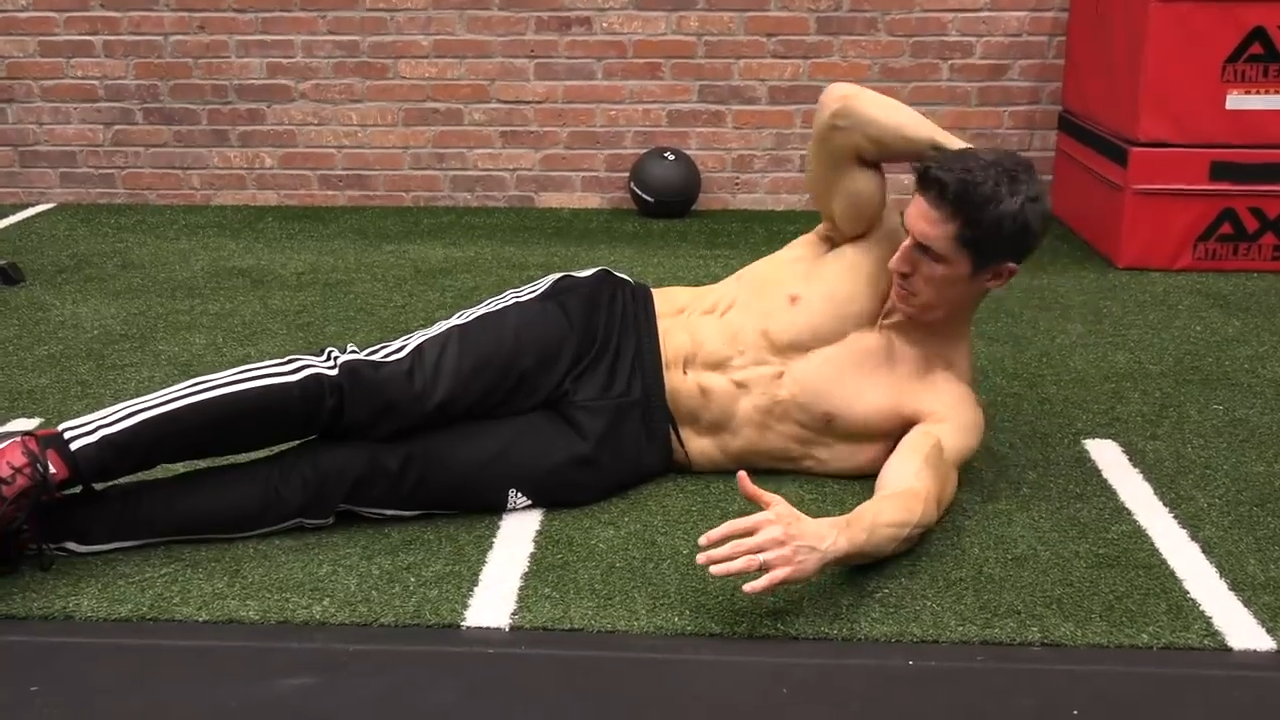
Most people will simply get on their side and do a bunch of reps that focus on a small range of motion.
These movements won’t fully engage your obliques, and this is why you might not be seeing results from your Side Crunches. Change up your form, focus on each rep, and you’ll see a big difference.
Also, a side note, I see a lot of guys do side crunches with a dumbbell behind their head. Avoid this.
There’s no need to use a dumbbell during this exercise. The slow contraction alone will be enough.
2.) SIDE BRIDGE

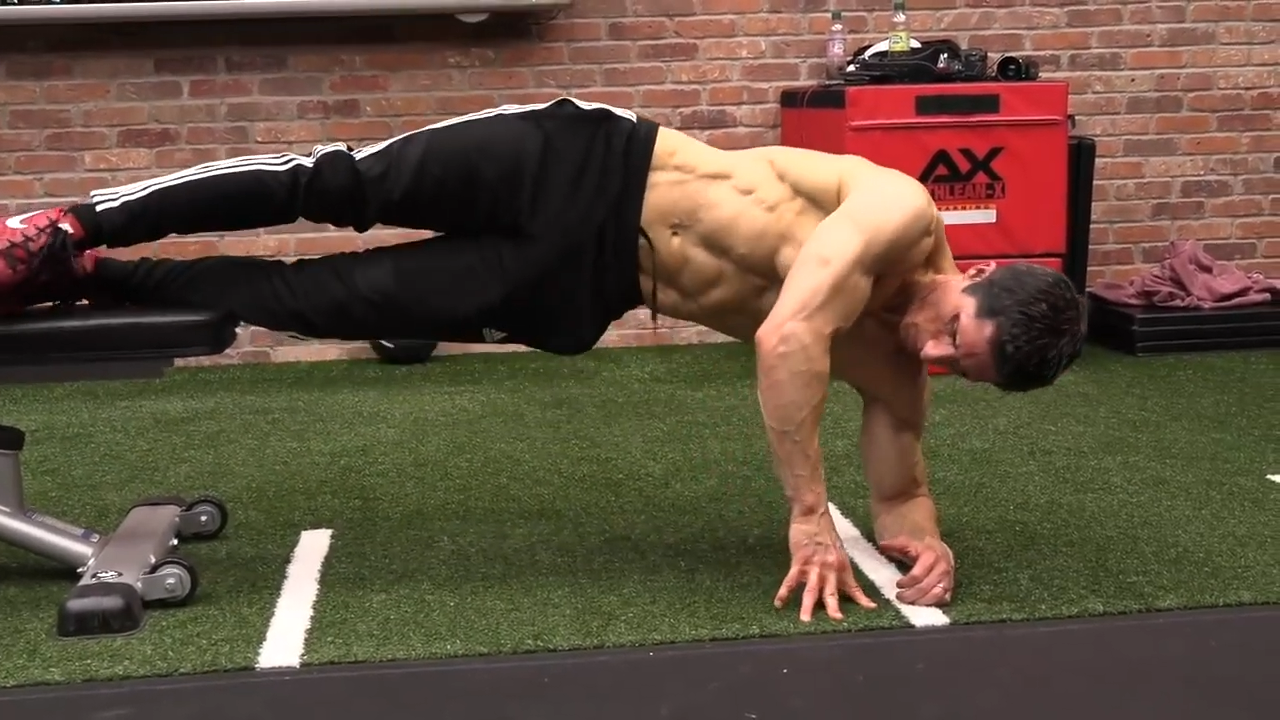
Next up, we have the Side Bridge. Unlike the Side Crunch, the Side Bridge is going to train your oblique muscles as a dynamic stabilizer.
In other words, you are going to remain in a static position while engaging the obliques to stabilize your torso.
The key is to activate the obliques that are nearest to the floor. This will allow you to achieve a sturdy pillar-like stability from your head to your toes.
Exercise Notes: Begin the exercise in an upright position with your forearm down on the ground and your feet elevated on a chair or stable surface. Your goal is to maintain a straight horizontal line while preventing rotation forward or backward. If you want to take this exercise to the next level, challenge yourself by dipping down a bit on every rep then re-establishing the stable position.
A quick heads up, the Side Bridge is NOT as easy as it looks, especially if you’re just starting out.
But it will pay you back tenfold, especially by creating that lateral trunk stability that often a lot of times we lack.
3.) ELBOW TO KNEE

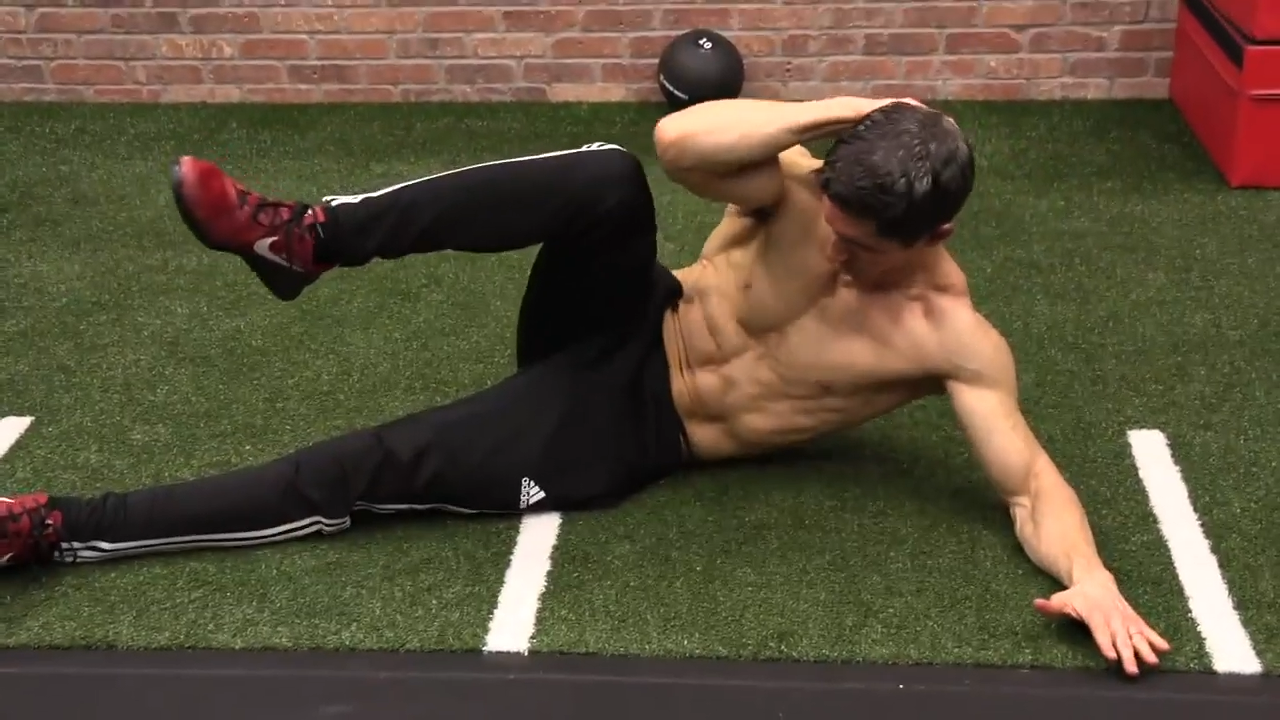
The next exercise we have is the Elbow to Knee.
It’s not about repetition count; it’s about repetition quality.
Remember to move slow enough so that you can engage in that much desired mind-to-muscle connection.
This isn’t the last time you’ll hear me say this but in order for you to properly target your obliques, you don’t want to rush through these.
For every good repetition you perform, you’re teaching your body how to recruit a muscle that is often overlooked.
4.) BROOMSTICK TWIST

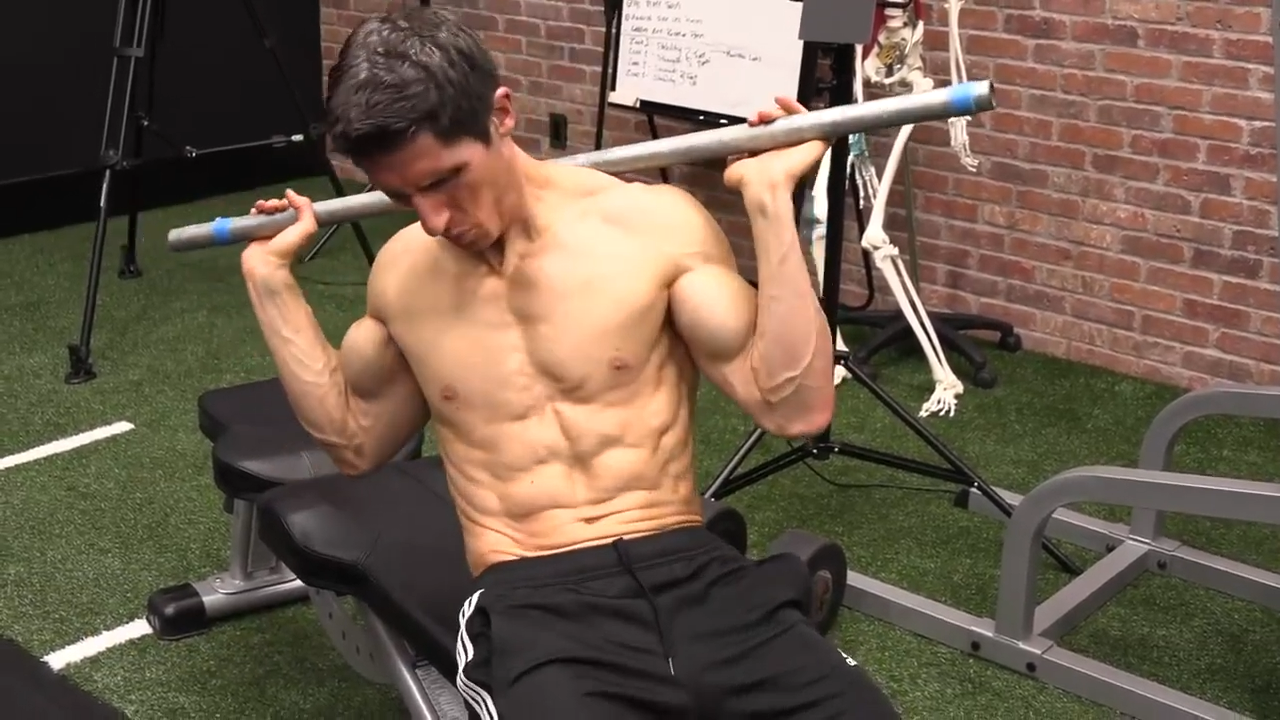
The Broomstick Twist is an old school ab exercise that is often done incorrectly.
It’s usually done with high repetitions in mind and no regard for the amount of rotation being forced by the lumbar spine.
It’s important to realize that this obliques exercise was never designed or intended for huge numbers of repetitions.
Exercise Notes: First, sit back into a posterior tilt and allow your thoracic spine to round a bit here, which is one of the very few times I’d be in favor of this. By doing so, you’re actually limiting the amount of rotation you’re going to get in your spine. But the rotation you do get will be driven by and controlled by the obliques. When you rotate in one direction, you’ll notice that the opposite obliques will alternately fire. Move slowly, trading in the repetition count for repetition quality, which should always be your focus.
5. ) PHYSIOBALL PLATE TWIST

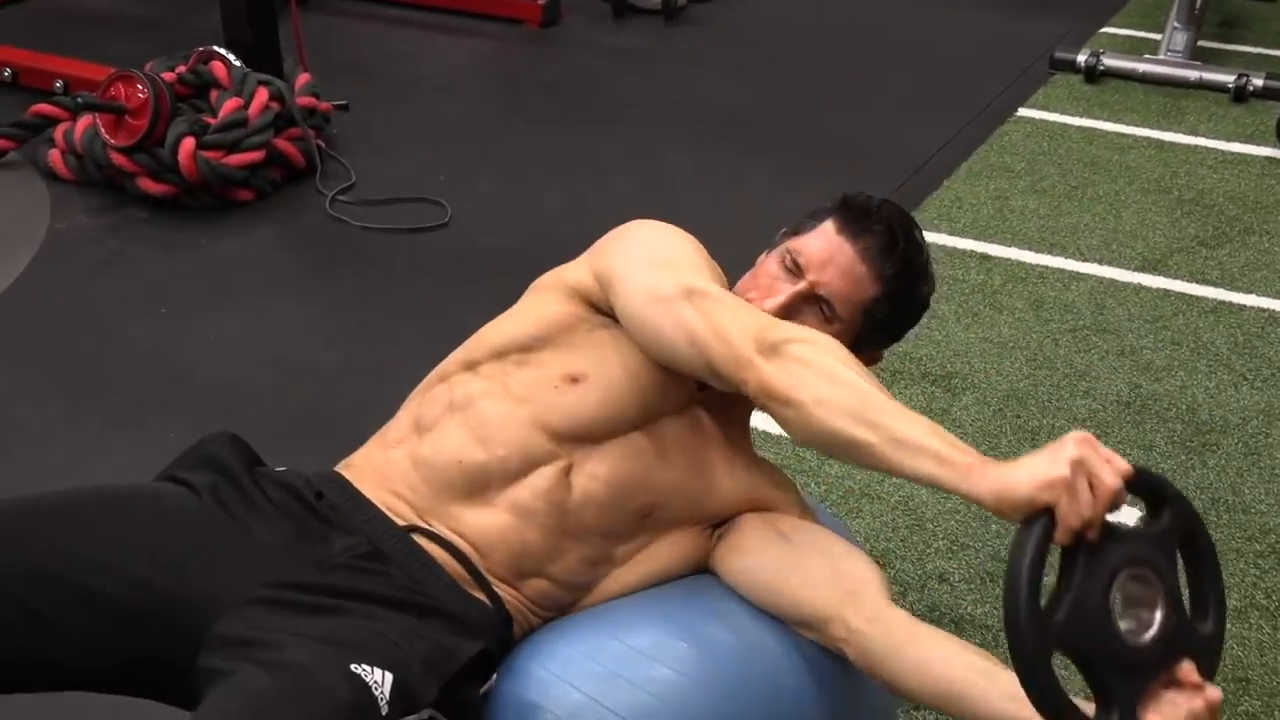
When people perform the Physioball Plate Twist incorrectly, they allow their whole body to spin and simply rotate on the ball.
The reality is that this doesn’t engage the obliques much.
The arms are basically staying aligned with the torso and there is no relative stress of rotation or control of rotation.
This is NOT a Physioball Plate Twist.

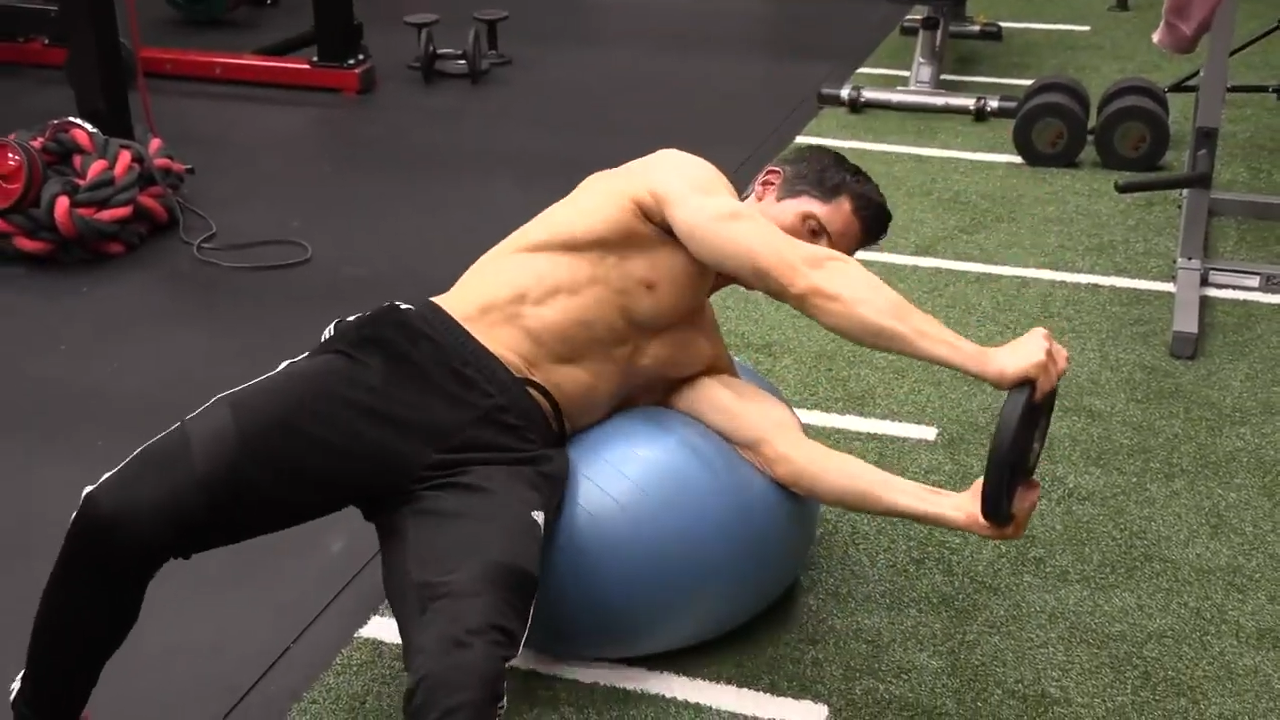
Instead, follow the instructions below and the video of the correct version of this exercise above.
This is a great exercise if done right, but not so valuable if done the first way.
And keep in mind that you don’t have to limit yourself to a weight plate. You can also use a medicine ball or a dumbbell. Just avoid using a heavy dumbbell at first.
Exercise Notes: Get your feet shoulder width apart. If you need more of a base, get your feet wider. Naturally, put your feet flat on the floor. Allow that plate to drop, keep the top arm straight if you can. Lower down, feel that weight as it gets further and further away from you. Get it back to center and rotate to the opposite side. You want to make sure that you’re trying to stabilize and control that rotation.
6.) ANTI-ROTATION PRESSOUT

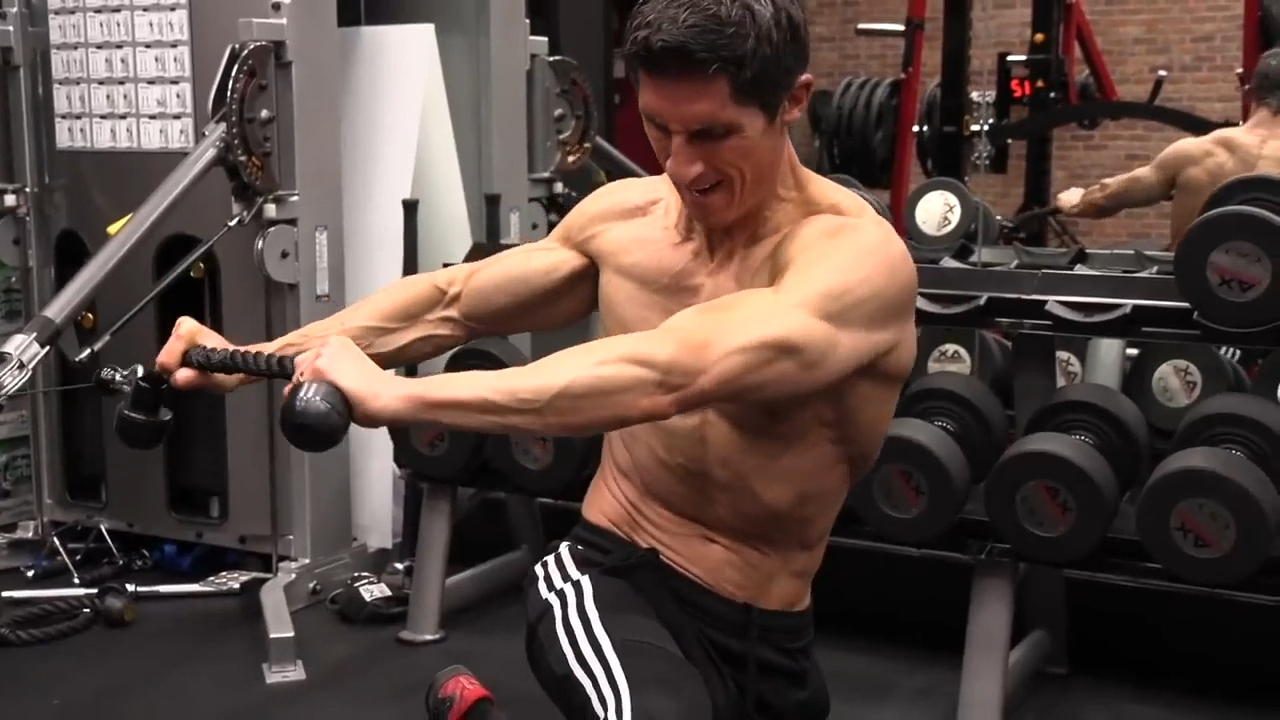
The Anti-Rotation Pressout is another twist obliques exercise.
It’s an amazing way to offset the load to one side and really challenge the anti-rotation function of the torso and obliques.
You can do this either in the half-kneeling position or more athletically, on your feet. Either way, it’s a great way to challenge your obliques in a more functional way as you progress.
For this exercise, you’ll be fighting against uneven loads. I prefer a cable rope or bar. You can also use a resistance band here but make sure that it’s securely attached to a wall.
Essentially what you’re trying to do is stabilize this upper body position and prevent the rotation that wants to happen.
Exercise Notes: Get into the starting position by positioning hands about shoulder-width on the bar or rope. Start from a half-kneeling position, driving your arm out and lock it there at shoulder height. Now, twist the torso toward the front without bending your arms. You’ll notice that you’re making 90-degree angles when going back and forth. Immediately you’ll feel that offset load that’s pulling you back and this is what you have to control. Take it slow and focus on that form and repetition quality. If you consider yourself one of the advanced exercisers, you can do a more dynamic variation of the exercise from a standing position. Take a piece of tape or chalk and create a straight line which will serve as your ending point. With the bar or rope at shoulder height, stride out and stride back, making sure that you keep that bar or rope orientated forward. I want the bar and my feet to match up with that straight line. In this more dynamic environment, I’m not allowing my obliques to break down and give in. Instead, I’m focusing on controlling that rotation.
7.) CORKSCREW TWIST

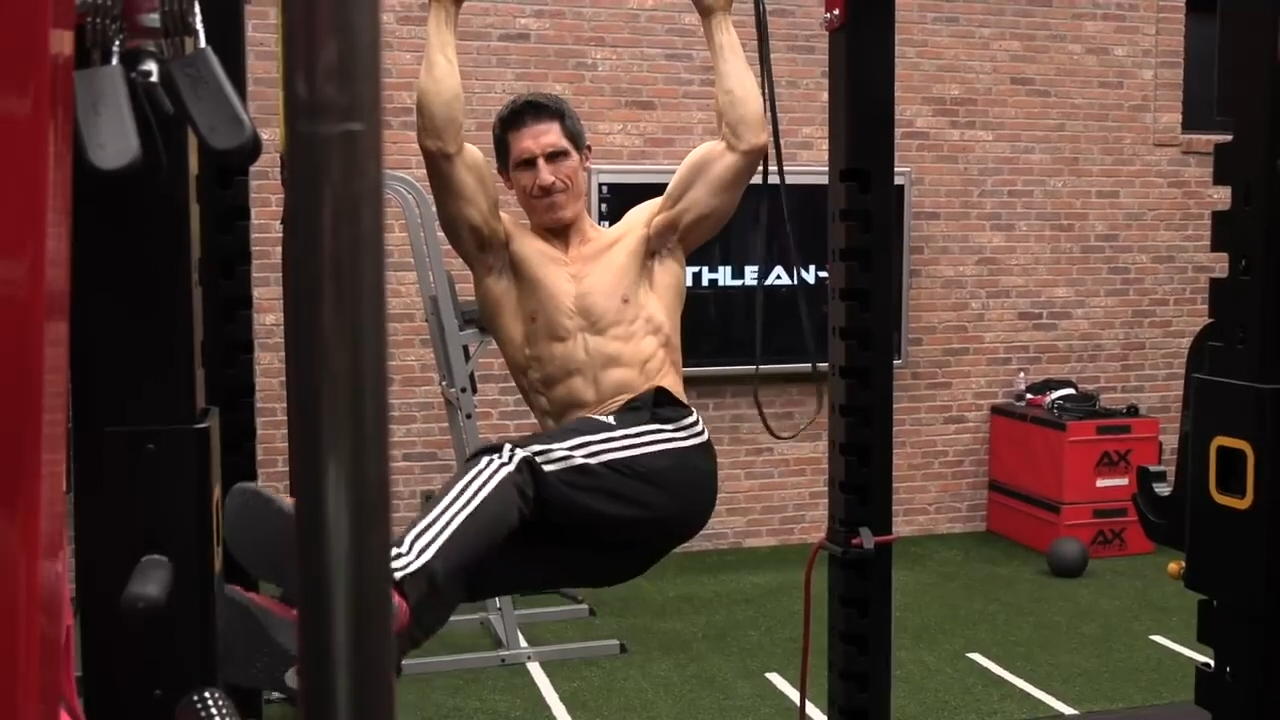
The Corkscrew Twist is an exercise that I absolutely love and here’s why:
If you can ditch your ego and forget about trying to go really high during a leg raise, you will feel this a hell of a lot more in your obliques.
Exercise Notes: Begin as you would a hanging leg raise but focus on initiating every single contraction with the obliques. If you’re focusing the contraction in your obliques and NOT the abdominal muscles, you’ll find that your legs won’t go as high, and that’s okay! Focus on twisting the entire pelvis while keeping the rest of your body straight. If you struggle with keeping your body stable during hanging exercises, just try to pull down an inch or two before you initiate the twist. You’ll find that you have a lot more stability because you’re reinforced above with your grip. This will keep you stable through each contraction and allow you to have more control over the movable parts.
8.) BANDED ELBOW THRUST


The next exercise here is called the Banded Elbow Thrust.
Just like with the Corkscrew Twist, we’re looking to control a small movement once again. And for this exercise, we’ll need a continuous-loop exercise band.
Exercise Notes: Make sure your resistance band is attached to a stable and secure surface from above, then wrap it around your elbow. From a standing position, step out and allow yourself to be pulled back a little bit towards the side of the band. This is that slight rotation that is very similar to the Side Crunch. The big difference here is that you’re not limited by the floor like you are with a Side Crunch so be sure to allow for that range of motion to happen. Slowly drive the elbow down towards the hip. Contract your obliques and slowly control the rotation back to the starting position.
9.) BANDED CAULDRON


The Banded Cauldron is my favorite obliques exercise.
Again, you’ll need a resistance band for this one. You can use a continuous-loop exercise band, but I prefer the type with a handle.
We know that the best way to challenge the obliques is to get into a position where you’re resisting rotation.
When using a resistance band, the goal would be to not allow the natural rotation back in the direction of a band. But I know we can do better.
We can target the obliques in a more dynamic way.
Exercise Notes: From a standing position, push the band out in front and then make circles. By making circles, you’re moving your arms further away from the body where it becomes more challenging. But this oblique exercise also introduces some lateral stability and control. Don’t forget to switch sides when you complete the reps for your starting side.
10.) LANDMINE WIPER

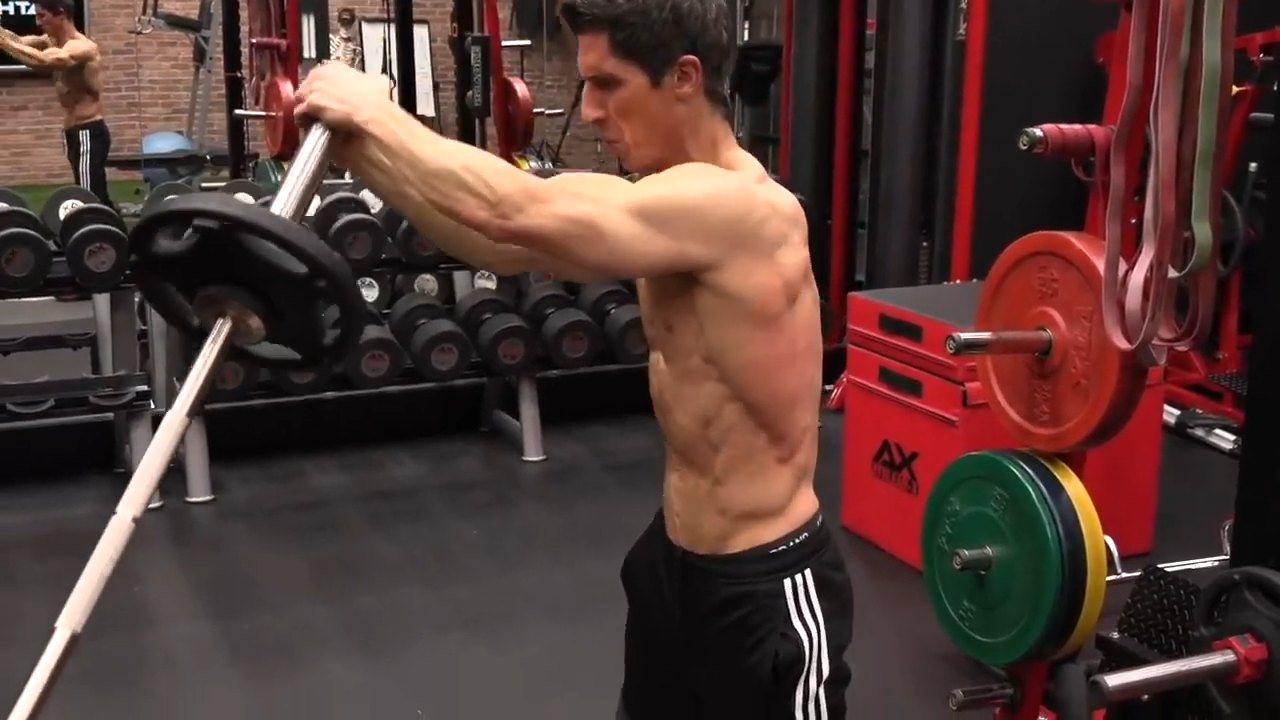
We finish strong with this wiper obliques exercise: the Landmine Wiper.
This is the king of rotational control exercises.
Exercise Notes: From a standing position, start off with long arms, holding the bar overhead. The weight at chest level is what you want. Then as you drop it down from one side to the other, I want you to fight to keep the top arm straight. This will demand a lot more control to keep that weight from falling to the ground. Guess what that means. hell of a lot more work for your obliques. Careful that the weight plate doesn’t hit your thigh as you rotate.
Guys, listen up: This is a tough exercise and you do NOT need to start with a heavy weight.
As a matter of fact, I want you to try it a time without weights. Just use the barbell at first because there’s a good chance that could be something that’s challenging for you. Start there and work your way up.
This is an invaluable way to train your obliques, and I don’t want you to miss out on it because you hurt yourself going too heavy.
One more thing about the Landmine Wiper:
And a lot of times, I’ll see people do this exercise incorrectly. Do NOT do this:


There’s a good chance that you recognize the common mistake here because it’s similar to what was done in the Physioball Plate Twist.
You do not want to allow your whole body to rotate. And you certainly don’t want to rely on the upper body strength of your arms and shoulders.
There’s no differentiation between what’s going on between the top and the bottom, which means your obliques won’t be sufficiently activated for you to see results.
Whether you wanted fat-burning exercises or strength-building exercises, you got both with my killer obliques workout. Don’t forget that these oblique workout moves are only effective when you perform them correctly. If you’re doing it the way I’m showing you here, your repetition counts may go down a lot, but the quality is going to go up a lot and that’s what we’re striving for here.
For more oblique workouts and exercises for a ripped midsection, check out some of our Athlean-X programs, all of which are based on science. We’re not winging it here. These programs use only those exercises and recommendations that have been backed by sports studies.
CORE4 ABS ==> Complete Core Training Program
AX1 ==> Train at Home With Dumbbells and Minimal Equipment
Program Selector ==> See which program best fits your goals

- Engage the oblique muscles and that mind-to-muscle connection by moving slowly and squeezing the muscle at the top of the movement.
- The Side Crunch is a dynamic stability exercise and when you perform it correctly, you are going to tap into full extension and contraction of the obliques.
- The focus of the Side Bridge is to create that pillar-like strength that the obliques provide us alongside our torso during movement.
- Elbow to Knee helps to posteriorly rotate the pelvis and intensify the contraction of the obliques on every rep.
- The Broomstick Twist demands quality, not quantity. Move slow and don’t worry about large numbers.
- During the Physioball Plate Twist, you’ve got to keep your torso steady and have your arms move outside of your torso to have the weight become a challenge to hold.
- Stabilize your upper body during the Anti-Rotation Pressout and prevent the rotation that wants to happen.
- Don’t worry about leg height during the Corkscrew Twist. Focus on initiating that small twist while keeping yourself locked in.
- Focus on a small forward movement with a full range of motion that extends backward with the Banded Elbow Thrust.
- Banded Cauldrons increase the difficulty when your arms are further from your body.
- Start light during the Landmine Wiper and keep the top arm straight.
The best exercise for obliques is the Side Crunch IF you do it with proper form. This means elongating the oblique muscles during the exercise to make sure the muscle is getting stretched on every rep. Go slow and making every repetition count.
Oblique exercises on their own will not help slim your waist if you have excess belly fat because abdominal and oblique exercises don’t burn fat. Oblique exercises do help sculpt the waist and those muscles will become visible if you have lower bodyfat. If belly fat is an issue for you, nutrition is will be important for helping you to slim your waist.
To tone the sides of your stomach you can try obliques exercises like Side Crunch, the Side Bridge and the Elbow To Knee. However, it’s important to know that if you have excess belly fat, you won’t be able to see the oblique muscles until you lose bodyfat through a solid nutrition plan.
The oblique muscles will only become visible if you have lower bodyfat levels because belly fat will cover these muscles. However, if you use weight training to target the oblique muscles, they will become bigger and because they’re located on the side of your torso large oblique muscles can have the effect of making your waist look bigger.
Three exercises that target the obliques the most are the Side Crunch, the Side Bridge and the Elbow To Knee.

Jeff Cavaliere M.S.P.T, CSCS
Jeff Cavaliere is a Physical Therapist, Strength Coach and creator of the ATHLEAN-X Training Programs and ATHLEAN-Rx Supplements. He has a Masters in Physical Therapy (MSPT) and has worked as Head Physical Therapist for the New York Mets, as well as training many elite professional athletes in Major League Baseball, NFL, MMA and professional wrestling. His programs produce “next level” achievements in muscle size, strength and performance for professional athletes and anyone looking to build a muscular athletic physique.

































